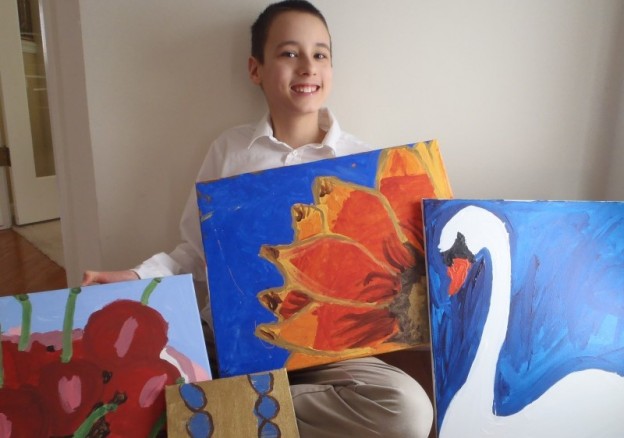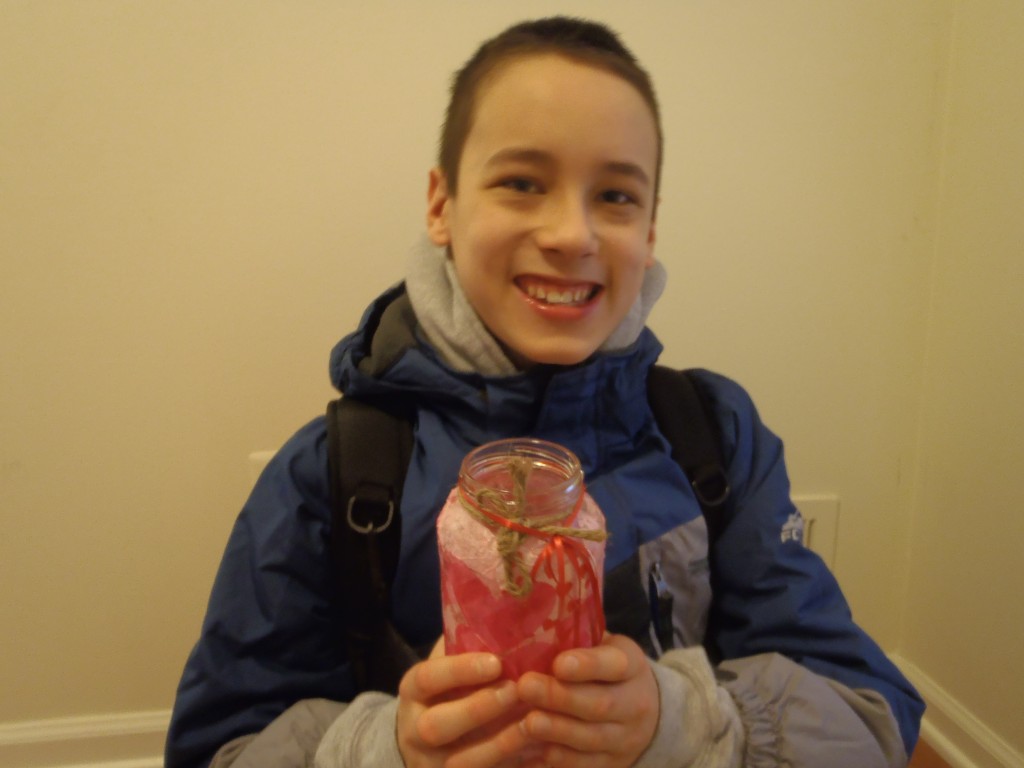
The Importance of the Arts in Special Education
Recently my son Louie came home from school with a decoupage vase filled with handmade paper flowers. He explained that he tore strips of paper, dipped them in a glue mixture and spread them on the vase to make a pattern. He said that he folded tissue paper and attached it to green pipe cleaners to make the flowers. My husband and I listened attentively to his detailed description, but we had to ask, “Where did you make your art project?” 
“In speech with Mrs. P,” he replied.
I thought to myself, that speech therapist is a genius.
But my husband was dismayed: “Why aren’t they doing speech in speech therapy?” he asked.
“This IS the speech therapy. I’ll bet those students didn’t stop talking during the whole project,” I said.
Sometimes its the extras that count
Special education is full of data and goals; “extras” such as fine or performing arts often fall by the wayside in the drive to achieve those goals. But more and more teachers, therapists and organizations are recognizing the fact that some students learn most effectively through the arts.
For example, there are cases of non-verbal students who can sing before they learn to talk. Social and adaptive skills can be taught through drama, as demonstrated in the Friendship Circle’s drama program, in which participants write and perform their own musical. Science, math and other academic subjects can be made more accessible through drawing, painting, sculpting and mixed media. And that’s just the beginning. The arts may offer a quantifiable strategy to develop skills and knowledge for students in special education.
So, what’s the evidence?
Research has consistently demonstrated that involvement in the arts increases student achievement across all subject areas, as well as social and adaptive skills. Part of this is due to the multi-sensory nature of the arts: memory and cognition improve when academic content is combined with color-coding, movement, rhythm, sound phrases, textures and other sensory input.
For example, when my son draws a diagram, map or visual interpretation for homework, he is more likely to remember the key terms and concepts. Medical studies have found that participation in creative arts reduces stress, which in turn enhances the ability to learn. In addition, because procedural memory is more reliable than short-term memory, the daily drills and routines of music, dance and drama classes allow a person with special needs to retain that knowledge and experience.
But for therapeutic goals, music therapy has the largest body of evidence to support its efficacy for students in special education, especially those with autism . Scientists hypothesize that music engages the mirror neuron system in the human brain, which supports development in sensory-motor integration, speech and social skills. Music therapy can be individualized to accomplish goals in fine motor skills, speech, social skills, emotional processing and memory.
Bringing the arts into self-contained classrooms
Many self-contained classrooms already take time every day for music and movement. Some school districts also have a music therapist either on staff or under contract to provide services for students in special education. In these cases, the therapist comes to the classroom and provides lessons tailored to the students’ needs and goals.
My friend Libby campaigns and fundraises every year to bring music therapy to her 7 year old son Sid’s classroom, because she has seen the positive effects firsthand: “Since he started music therapy, I have noticed that Sid has been trying to communicate more, his eye contact is better, he seems to want to connect with me more. One song he learned at music therapy is "Yellow Submarine" by The Beatles. He has been singing that around the house non-stop!”
Not Just for Music Therapists
Therapists in other fields such as speech and social work can also use the arts to work on specific goals. When I was listening to my son explain the art project that he made in speech therapy, I understood that he was working on the following goals:
- receptive language
- comprehending and following a multi-step process
- requesting items needed for each step
- using “I” statements to describe preferences in color and style
- using appropriate third-person pronouns to describe the work of other students
- tolerating different textures (wet, dry, sticky)
- developing fine motor skills
Projects may be modified for different purposes, depending on the situation. For example, a facilitator may choose to focus on emotional aspects of creativity or creative problem solving skills, or, in the case of drama therapy, emerging literacy skills through the practice and recitation of a script. The book “Making Art Special: A Curriculum for Special Education Art” by Helen Shafton has more than fifty adaptable lesson plans that can be coordinated with classroom goals.
Using the arts as the means for inclusion
When I went to parent-teacher conferences at my son’s middle school last year, his art teacher confessed sheepishly, “I didn’t even realize that Louie had special needs until it was time to collect the projects, and I asked him why his wasn’t finished. He followed instructions just fine and worked cooperatively with the other students. He just needed extra time for his work.”
I wasn’t sure if I should be pleased or dismayed. On the one hand, Louie was sitting with friends and the teacher had the same expectations of all students, regardless of ability. On the other hand, the teacher really should have looked at Louie’s IEP at the beginning of the semester!
Because art, music and drama classes are based on creative expression instead of test scores, they are usually the first choice for inclusion. Students with special needs can assist the teacher with organizational duties just like all the other students. They have the opportunity to explore creative media in small groups alongside general education peers. Since there is more than one “right” answer, students have the opportunity to appreciate and enjoy each other’s work - that's social inclusion at its best.
Last month Louie performed in his school’s spring choir concert. I am in frequent contact with the teacher, who sends home notes and worksheets to help Louie practice. As a result, my son has developed a strong sense of competency and confidence, and it’s difficult for me to keep a dry eye while he sings his heart out on stage. The arts provide the perfect opportunity for him to give his personal best.
In a 2011 lecture for the National Art Education Association, special educator and art educator Beverly Levett Gerber said, “Art education for students with special needs is filled with ‘No’s’ – ‘No money, no time, no space, no materials, sorry – never done that before.’ Special education taught me the value of working with others...Together, art educators and special educators can be a powerful voice.”
So don’t accept “no” for an answer. Get creative today.



